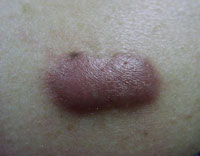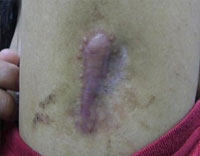Both are the result of overzealous collagen synthesis together with limited collagen lysis during the remodeling phase of wound healing.
Hypertrophic scars are thickened, firm, but only slightly raised. They only lie within the boundary of injury without extending into adjacent normal tissue, and may regress with time.
Keloids are actually benign tumours of scar tissue. They continue to grow beyond the boundary of an original injury, sometimes can be extensive and many times the size of the original wound. They are raised, reddish-purple in colour and are firmer than hypertrophic scars.
 |
 |
Keloids have a genetic component and run in the family. It is more common in darker skin people than people with lighter skin. Some areas such as the chest, knees and elbows are more likely to develop keloids.
Significant improvement in hypertrophic scars is possible with the 585nm pulsed dye laser. Keloids usually require the simultaneous injection of Triamcinolone, a steroid that inhibits production of the collagen that makes up scar tissue, reduces inflammation, and helps a scar to regress.

